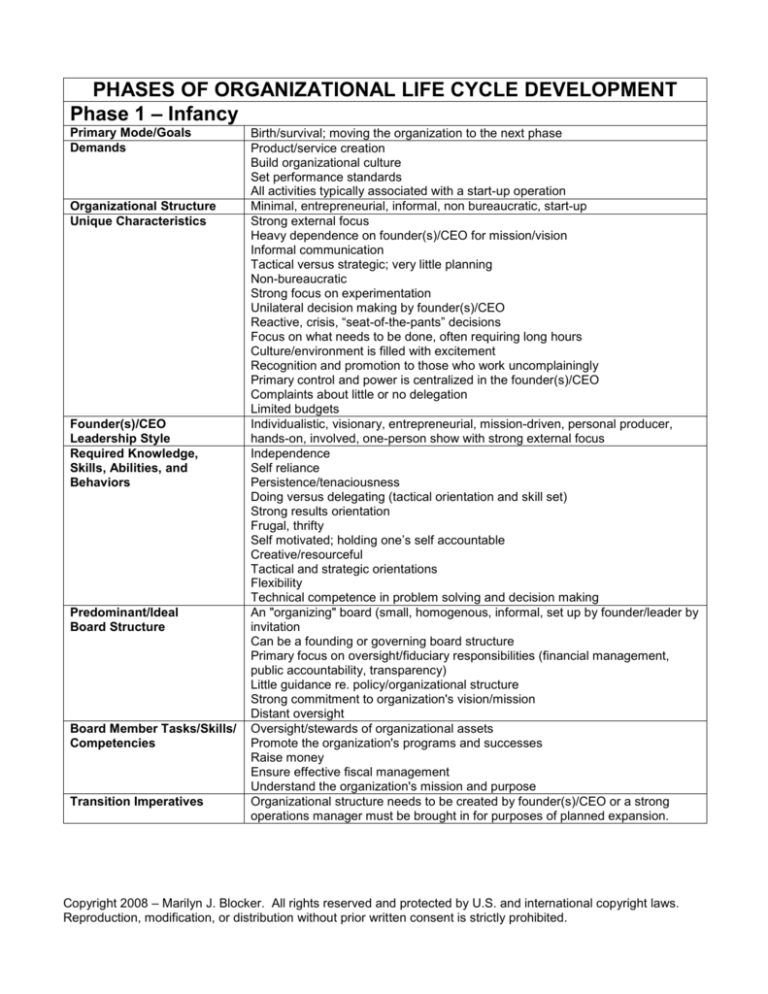
PHASES OF ORGANIZATIONAL LIFE CYCLE DEVELOPMENT
Phase 1 – Infancy
Primary Mode/Goals
Demands
Organizational Structure
Unique Characteristics
Founder(s)/CEO
Leadership Style
Required Knowledge,
Skills, Abilities, and
Behaviors
Predominant/Ideal
Board Structure
Board Member Tasks/Skills/
Competencies
Transition Imperatives
Birth/survival; moving the organization to the next phase
Product/service creation
Build organizational culture
Set performance standards
All activities typically associated with a start-up operation
Minimal, entrepreneurial, informal, non bureaucratic, start-up
Strong external focus
Heavy dependence on founder(s)/CEO for mission/vision
Informal communication
Tactical versus strategic; very little planning
Non-bureaucratic
Strong focus on experimentation
Unilateral decision making by founder(s)/CEO
Reactive, crisis, “seat-of-the-pants” decisions
Focus on what needs to be done, often requiring long hours
Culture/environment is filled with excitement
Recognition and promotion to those who work uncomplainingly
Primary control and power is centralized in the founder(s)/CEO
Complaints about little or no delegation
Limited budgets
Individualistic, visionary, entrepreneurial, mission-driven, personal producer,
hands-on, involved, one-person show with strong external focus
Independence
Self reliance
Persistence/tenaciousness
Doing versus delegating (tactical orientation and skill set)
Strong results orientation
Frugal, thrifty
Self motivated; holding one’s self accountable
Creative/resourceful
Tactical and strategic orientations
Flexibility
Technical competence in problem solving and decision making
An "organizing" board (small, homogenous, informal, set up by founder/leader by
invitation
Can be a founding or governing board structure
Primary focus on oversight/fiduciary responsibilities (financial management,
public accountability, transparency)
Little guidance re. policy/organizational structure
Strong commitment to organization's vision/mission
Distant oversight
Oversight/stewards of organizational assets
Promote the organization's programs and successes
Raise money
Ensure effective fiscal management
Understand the organization's mission and purpose
Organizational structure needs to be created by founder(s)/CEO or a strong
operations manager must be brought in for purposes of planned expansion.
Copyright 2008 – Marilyn J. Blocker. All rights reserved and protected by U.S. and international copyright laws.
Reproduction, modification, or distribution without prior written consent is strictly prohibited.
PHASES OF ORGANIZATIONAL LIFE CYCLE DEVELOPMENT
Phase 2 – Adolescence
Primary Mode/Goals
Demands
Organizational Structure
Unique Characteristics
Founder(s)/CEO
Leadership Style
Required Knowledge,
Skills, Abilities, and
Behaviors
Predominant/Ideal
Board Structure
Board Member Tasks/
Skills/ Competencies
Transition Imperatives
Growth/independence; goal is to distribute power (and empower) so that the
organization can move to the next phase
Need for well-communicated goals/direction; empowered employees and middle
managers; mechanisms to coordinate work of a complex and growing
organization that is moving from entrepreneurship to professional management.
Primarily informal; some procedures; some delegation
Policies/procedures, although few, are probably not adhered to
Complaints about too many priorities
Rapid growth
Internal and external focus
Although a few systems are in place, control is mostly informal.
Inconsistencies in policies and practices appear
Goals are being formulated and functional areas created.
Need for quality products/services is apparent
Employees feel part of a strong organizational community/team
Employees and leaders still exited about vision and making significant
investments in the organization, in both time and energy
Conflict becomes evident between “old-timers” and “newcomers”
Administrative systems are needed and sometimes founders/CEOs want to
continue running a “one-person show”
Too many products and programs may evolve
Sometimes entrepreneurial-type leaders/employees leave (including
founders/CEOs) and administrative-oriented leaders/employees stay
Many employees and middle managers begin striving for independence
Morale can suffer over questions of who should be in control
Charismatic, mission focused
Strategic
Delegation to one of two other key leaders
Refinement/enhancement of initial structure (e.g., policies, processes, etc.)
Admit/learn from mistakes and make changes accordingly
Objectively evaluate and manage performance
Hold others accountable
Recognize strong and consistent performance
Take action when performance is below expectations
An "organized" board (small, homogenous, informal, but has a sense of
ownership and feels responsible for controlling the organization's destiny and
guiding its leaders
Ensure that the organization is in synch with mission and values
Work with CEO to promote the organization's brand
Ensure sound risk management
Continue effective fiscal management
Support the founder(s)/CEO in making necessary changes
Devise formal mechanisms for evaluating performance of the executive team
Develop process for selecting/orienting new board members
Work with the founder(s)/CEO to determine appropriate roles and boundaries
Ability to exercise higher degree of control than in start-infancy phase
Top-down (command-and-control) styles need to be replaced to effectively
empower senior/middle management teams and employees
Senior leadership must give up some responsibility/authority/control
Founder/CEO must build strong relationships with staff and board
Founder/CEO and board must create risk management strategies and utilize
risk-reward ratios for product/program planning and operational decision making
Copyright 2008 – Marilyn J. Blocker. All rights reserved and protected by U.S. and international copyright laws.
Reproduction, modification, or distribution without prior written consent is strictly prohibited.
PHASES OF ORGANIZATIONAL LIFE CYCLE DEVELOPMENT
Phase 3 – Middle Age
Primary Mode/Goals
Demands
Organizational Structure
Unique Characteristics
Founder(s)/CEO
Leadership Style
Required Knowledge,
Skills, Abilities, and
Behaviors
Predominant/Ideal
Board Structure
Board Member Tasks/
Skills/Competencies
Transition Imperatives
Maturity, interdependence, reinvention, building of strong partnerships because
of increased organizational complexity. Goal is to strengthen infrastructure and
develop formal accountability mechanisms for performance
Installation of formal processes/procedures and control systems; infrastructure
analysis and modification to respond to continued growth and/or internal/external
challenges. Likely need for centralization of support services, process redesign,
downsizing to ensure effectiveness, efficiency, and internal stability
Integrated technology, formal planning, strategy, processes, policies, and
procedures to monitor/manage performance and ensure accountability
Division of labor with addition of functional specialists
Strong focus and investment in infrastructure but little investment in training
Continuous process improvement
Increased pressures to focus on financial outcomes for growth/sustainability
Cumbersome/overlapping/conflicting procedures/policies
Employees and middle managers want more control
Senor leaders not prone to giving up power/control
Silos among functional areas and/or between line and staff employees
Heavy investment in infrastructure (versus thrift and frugality of early cycles)
Effective balance between mission focus and business focus and from
entrepreneurial to professional management
Increased self awareness/knowledge of impact on team and others
Increased need for formal strategic and operations planning and performance
scorecards
Delegation w/formal control (follow-up and development of control mechanisms)
Team problem solving, decision making, and conflict management skills
Response to different styles; management and leveraging of diversity
Leader selection skills
Skills in team management and change management
Knowledge of organizational redesign/restructuring
Volunteer governing board (Overseeing takes on the form of standing
committees and task forces; more focus on CEO accountability)
Board needs to move away from the rudimentary levels of Stages 1 and 2 and
place focus on strategic management, joint leadership, and leader/CEO
accountability
Board needs to shift focus to governance, social accountability, and long-term
sustainability
High-level volunteerism to be introduced on event/project basis
Active participation in board development initiatives
Strong partnership with founder(s)/CEO regarding strategy formulation, issue
identification, framing of problems, and creative problem solving
Direction of founder(s)/CEO strong linkage with Board facilitated through formal
strategic and operating plan development, implementation, and monitoring
Possible expansion of the board and change in composition
Leadership competency model established for executive team and board
Evaluation of founder(s)/CEO/board member performance against new
requirements for growth and
sustainability
Increased knowledge of the organization’s management and operations
Senior leader(s) must construct and communicate strategic plan, timelines,
accountabilities, intended outcomes; must also distribute power, manage
change, oversee infrastructure building/rebuilding, develop accountability
mechanisms for control and coordination, and continually strengthen board
relations
Copyright 2008 – Marilyn J. Blocker. All rights reserved and protected by U.S. and international copyright laws.
Reproduction, modification, or distribution without prior written consent is strictly prohibited.
PHASES OF ORGANIZATIONAL LIFE CYCLE DEVELOPMENT
Phase 4 – Maturity
Primary Mode/Goals
Demands
Organizational Structure
Unique Characteristics
Founder(s)/CEO
Leadership Style
Required Knowledge,
Skills, Abilities, and
Behaviors
Predominant/Ideal
Board Structure
Board Member Tasks/
Skills/Competencies
Transition Imperatives
Build upon past strengths to leverage organizational knowledge, make optimal
use of technology and human capital; sustain momentum by maintaining
reputation and by redesigning when necessary to prevent decline
Need for revitalization and continual reinvention and redesign
Team approaches to maintain success (i.e., employee buy-in and leader
sponsorship of reinvented organization
Decentralization
Organization may have to be broken up into smaller (more entrepreneurial) units
Small organization thinking within bureaucratic structures
High performance culture required for sustainability
Collaborative/team approaches because of increased complexity and
involvement in restructuring
Formal control systems replaced by cross-functional task forces and teams that
assemble and disassemble, based on organizational need
Complaints about not enough well-trained leaders and employees
Periods of temporary decline that need to be actively managed
Reorganization to meet changing needs
Outcome-based versus task-based focus
Formal succession planning initiative in place
Increased team problem solving and decision making with focus on innovation
Team focused
Negotiation
Collaboration
Strategic and tactical organization (as organization splits into smaller parts)
Influence management skills
Best practice identification and utilization
Integrating activity across functions
Continual relationship building and enhancement
Ongoing support of creativity and innovation
Ability to create a culture of appreciative inquiry and continuous learning
An institutional board with two main demands: (a) alternative or multiple sources
of funding and (b) higher public accountability
Collaborative leadership between board and executive management team
Board involved in analysis of what drives (or should drive) strategy prior to the
strategic planning process
Ability to think “retrospectively,” learning from the past while still anticipating the
needs of the future
Need for proactive rather than reactive approaches to opportunities and threats
Board to move from a purely fiduciary role to that of generativity and direction
setting
Board may need to expand or be broken up into separate boards for units in
response to decentralization
Summed up in a quote by Alvin Toffler in his book, The Third Wave: “The
illiterate of the 21st century will not be those who cannot read and write, but those
who cannot learn, unlearn, and relearn.”
Copyright 2008 – Marilyn J. Blocker. All rights reserved and protected by U.S. and international copyright laws.
Reproduction, modification, or distribution without prior written consent is strictly prohibited.

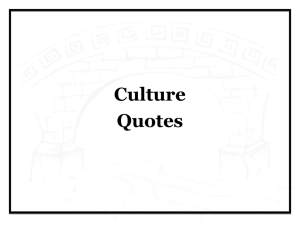
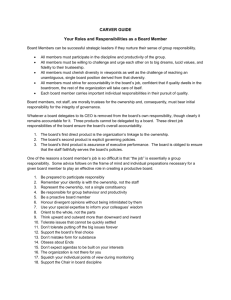
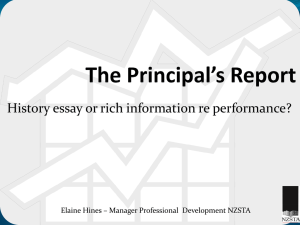
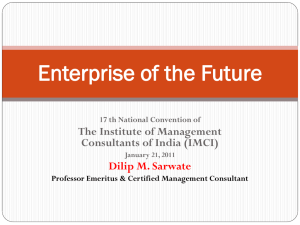
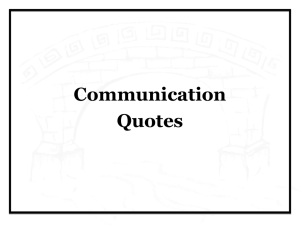
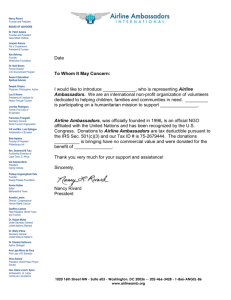
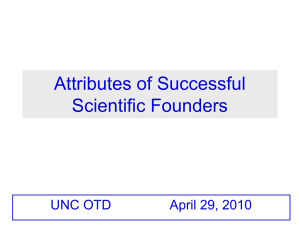
![Linehan - Stanford Biodesign - BME Idea Europe 2015[3]](http://s3.studylib.net/store/data/008154436_1-7df8258a4152706b958815988d9e8040-300x300.png)